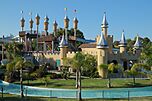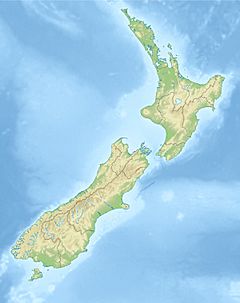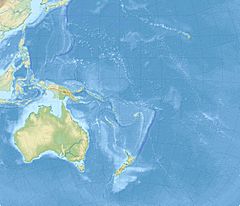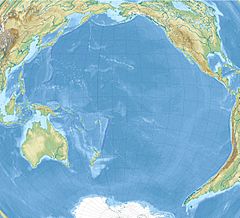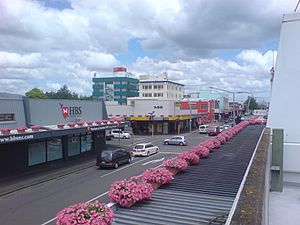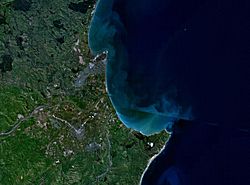Hastings, New Zealand facts for kids
Quick facts for kids
Hastings
Heretaunga (Māori)
|
|
|---|---|
|
From top, left to right: Saint Matthew's Church, Hastings CBD, Toitoi Events Centre, Nga Pou o Heretaunga, Splash Planet castle, Lion sculpture at Cornwall Park
|
|
| Motto(s):
Urbis Et Ruris Concordia (Town and Country in Harmony)
|
|
| Country | New Zealand |
| Island | North Island |
| Region | Hawke's Bay |
| Territorial authority | Hastings District |
| Settled by Māori | c. 14th Century |
| Settled by Europeans | c. 19th Century |
| Area | |
| • District | 5,226.62 km2 (2,018.01 sq mi) |
| • Urban | 26.29 km2 (10.15 sq mi) |
| Elevation | 11 m (36 ft) |
| Population
(June 2023)
|
|
| • District | 91,900 |
| • Density | 17.583/km2 (45.540/sq mi) |
| • Urban | 51,500 |
| • Urban density | 1,958.9/km2 (5,074/sq mi) |
| Postcode(s) |
4120, 4122
|
| Website | HastingsDC.govt.nz |
Hastings (/ˈheɪstɪŋz/; Māori: Heretaunga) is an inland city of New Zealand and is one of the two major urban areas in Hawke's Bay, on the east coast of the North Island. The population of Hastings (including Flaxmere) is 51,500 (as of June 2023), with a further 15,200 people in Havelock North and 2,090 in Clive. Hastings is about 18 kilometres inland of the coastal city of Napier. These two neighbouring cities are often called "The Bay Cities" or "The Twin Cities".
The city is the administrative centre of the Hastings District. Since the merger of the surrounding and satellite settlements, Hastings has grown to become one of the largest urban areas in Hawke's Bay.
Hastings District is a food production region. The fertile Heretaunga Plains surrounding the city produce stone fruits, pome fruit, kiwifruit and vegetables, and the area is one of New Zealand's major red wine producers. Associated business include food processing, agricultural services, rural finance and freight. Hastings is the major service centre for the surrounding inland pastoral communities and tourism.
Contents
History
Māori history
Near the fourteenth century CE, Māori arrived in Heretaunga or Hawke's Bay, settling in the river valleys and along the coast where food was plentiful. It is believed that Māori arrived at Heretaunga by canoe, travelling down the coast from the north, landing at Wairoa, Portland Island, the Ahuriri Lagoon at Westshore, and at Waimarama. Their culture flourished, along with gradual deforestation of the land, making this one of the few regions of New Zealand where sheep could be brought in without felling the bush first. In the sixteenth century, Taraia, great-grandson of the great and prolific chief Kahungunu, established the large tribe of Ngāti Kahungunu, which eventually colonised the eastern side of the North Island from Poverty Bay to Wairarapa. They were one of the first Māori tribes to come in contact with European settlers.
European settlers' history
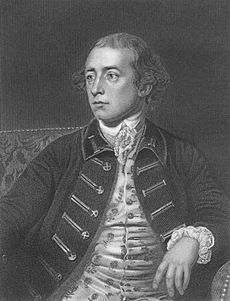
The Māori owners leased approximately seventy square kilometres on the Heretaunga Plains to Thomas Tanner in 1867; Tanner had been trying to purchase the land since 1864. In 1870, twelve people, known as the "12 apostles", formed a syndicate to purchase the land for around £1 10s an acre (£371 per km2). Many local people firmly believe that Hastings was originally named Hicksville, after Francis Hicks, who bought a 100-acre (0.40 km2) block of land, which now contains the centre of Hastings, from Thomas Tanner. However, this story is apocryphal. The original name of the location which was to become the town centre was Karamu.
In 1871, the New Zealand Government decided to route the new railway south of Napier through a notional Karamu junction in the centre of the Heretaunga Plains. This location was on Francis Hicks's land. The decision on the railway route was based largely on two reports by Charles Weber, the provincial engineer and surveyor in charge of the railway. Karamu junction was renamed Hastings in 1873. (On 7 June 1873, the Hawke's Bay Herald reported: "The name of the new town is to be Hastings. We hear it now for the first time.") Exactly who chose the name has been disputed, although Thomas Tanner claimed that it was him (see Hawke's Bay Herald report 1 February 1884) and that the choice was inspired by his reading the trial of Warren Hastings. In any event, the name fitted well with other place names in the district (Napier, Havelock and Clive), which were also named after prominent figures in the history of British India. In 1874, the first train took the twelve-mile (19 km) trip from Napier to Hastings, opening up Hastings as an export centre, through Port Ahuriri. A big jump in the local economy occurred when Edward Newbigin opened a brewery in 1881. By the next year, there were 195 freeholders of land in the town and with around six hundred people, the town was incorporated as a borough on 20 October 1886.
Hastings first received power in 1912, followed by Napier in 1915.
In 1918, nearly 300 people died of a flu epidemic that swept Hawke's Bay.
1931 earthquake
On 3 February 1931, at 10:47 am, most of Hastings (and nearby Napier) was levelled by an earthquake measuring 7.8 on the Richter Scale. In Hastings, the ground subsided roughly 1 metre. The collapse of buildings and the ensuing fires killed 258 people, of which 93 were in Hastings. The centre of Hastings was destroyed in the earthquake, and was subsequently rebuilt in the Art Deco and Spanish Mission styles, which were both popular at that time. Due to quick thinking by residents and the Local Fire Department, Hastings did not suffer the extent of fire damage that Napier did. Most deaths were attributed to collapsing buildings, namely Roaches' Department Store in Heretaunga Street where 17 people died.
1932 to 1999
During World War II, Allied troops were billeted at the Army, Navy and Air Force (ANA) Club, and in private homes. One hundred and fifty members belonging to sixteen different local clubs packed supplies to be sent to Allied soldiers. In 1954, Hastings was the first city in New Zealand to introduce fluoridation of its water supply. The intention was to compare the effect on tooth decay with that in the unfluoridated city of Napier over a ten-year period. The study was criticised for its methodology and results, and remains controversial.
On 10 September 1960, the Hastings Blossom Parade (at the time a significant national event) was cancelled at 11 am for the first time in its history due to rain. ..... This was considered a significant event in New Zealand society with modern youth rebellion culture being labelled antisocial, and was subsequently much publicised with the national election later that year.
Hastings grew rapidly throughout the 1960s and 1970s (Hastings at this time was the fastest growing city in New Zealand), and there was a major issue dealing with encroachment of suburban expansion on highly productive land. Flaxmere was established as a satellite suburb to absorb rapid growth and was built upon the stony arid soils of the abandoned course of the Ngaruroro River. Although the land seemed worthless back then, it has subsequently proved highly valued for grape growing, and now is a prized region of red wine varietals in the world-famous Gimblett Gravels wine-growing region. Starting with economic decline nationally in the late 1970s, coupled with agricultural subsidy reforms in the early 1980s, Hastings went into recession with more unemployment and low economic growth. It was not until the mid 1990s that the economy of Hastings began to turn around.
During the 1989 local government reforms Hastings City amalgamated with the Havelock North Borough and Hawke's Bay County to form the modern Hastings District. The County Council offices in Napier were closed in favour of Hastings and the new Hastings District Council offices were built on two sites. The Napier City boundary was expanded to include Bay View and Meeanee. However, unlike largely urban Napier (population density 540.0 per km2), much of the newly formed Hastings District is rural and sparsely populated (population density 14.0 per km2), the Hastings District has approximately 84,000 (June 2018) residents.
Because of their proximity to each other and their relatively small populations, Hastings and Napier are often seen as candidates for further amalgamation. This was attempted with the 1999 Amalgamation Referendum where 75% of Napier residents opposed, and 64% of Hastings residents were in support.
2000 to today
At 11.25 pm on 25 August 2008, the city was hit by an earthquake measuring 5.9 on the Richter scale. The epicentre was based only 10 km south of the city, near Mt Erin at a depth of 32 km. The earthquake caused minor damage to shops, where stock was shaken off shelves. Power outages were also reported. This was the most powerful earthquake to hit the region since the 5.8 Hastings earthquake in October 2001.
In 2010, the city, together with New Plymouth became one of the two walking and cycling "model communities", qualifying for further co-funding by the national government to improve its walking paths and cycleways, and encourage people to use active forms of transport.
In August–September 2016, 5,200 people fell ill with campylobacteriosis after the local water supply in Havelock North tested positive for the pathogen Campylobacter jejeuni. Two deaths occurred from campylobacteriosis, both in nursing homes. It is suspected that after heavy rain fell on 5–6 August, water contamination from flooding caused the outbreak, although this is the subject of a government Inquiry. It is the largest outbreak of waterborne disease ever to occur in New Zealand. All schools in Havelock North closed for two weeks, with the Hastings District Council advising an urgent notice to boil water for at least one minute before consumption. This notice was lifted on September the 3rd, with the outbreak officially under control. Chlorination of the Havelock North water supply started on Friday the 12th, and 9 water tankers were brought in containing water from the Hastings water supply. One of these trucks again tested positive for E-Coli contamination, prompting the Hastings District Council to chlorinate the water supply of both Hastings and Flaxmere as a precautionary measure.
Timeline
- 1867: Māori owners leased 70 sq kilometres of land from the Heretaunga Plains to Thomas Tanner, it was the site of Karamu Junction.
- 1873: The town of Karamu Junction is officially renamed Hastings.
- 1874: Hastings (along with Napier) is connected to the North Island Main Trunk Line.
- 1886: 20 October. Hastings town is incorporated as a Borough.
- 1912: Hastings is connected to electricity, followed by Napier in 1915.
- 1918: Nearly 300 people die of a flu epidemic that swept Hawke's Bay.
- 1931: 3 February. Hastings is rocked by a 7.8 magnitude earthquake, killing 256 people (93 in Hastings).
- 1932: 16 September. Hastings is rocked by a 6.9 magnitude earthquake. It is the final large earthquake in the 1931–1932 earthquake events.
- 1950: The first Blossom Parade was held in Hastings and is now a popular annual event.
- 1951: 10 February. Hastings is rocked by a 6.1 magnitude earthquake at 3:27 pm.
- 1954: Hastings was the first city in New Zealand to introduce fluoridation of its water supply.
- 1960: 10 September. The Hastings Blossom Parade (at the time a significant national event) was cancelled at 11 am for the first time in its history due to rain.
- 1989: Hastings City and the Havelock North Borough amalgamated to form the modern day Hastings District.
- 1993: 11 April. A 6.1 magnitude earthquake strikes 15 km south-west of Hastings and is felt as far south as Christchurch.
- 2008: 25 August. A 5.9 magnitude earthquake centred 10 km south of Hastings caused an estimated $5 million in damage.
- 2010: The city became a walking and cycling "model community".
- 2016: August and September. 5,200 residents fall ill with campylobacteriosis, prompting a district-wide health crisis. It is the largest outbreak of waterborne disease to ever occur in New Zealand.
Geography and climate
Located on New Zealand's east coast, to the east of the Central Plateau and the rain shadow of the Kaweka Ranges, Hastings is situated on the fertile alluvial Heretaunga Plains. The plains were originally covered in swamp and mangroves, but have since been drained for agriculture. The local area is very productive, with orchards, farms and vineyards, and lies upon New Zealand's most economically valuable aquifer. Hastings lies roughly 250 km north-east of the nation's capital Wellington (294 km by road) and 350 km south east of the largest city, Auckland (429 km by road).
 |
Napier |  |
||
| Taihape and Tongariro National Park | Cape Kidnappers | |||
| Waipukurau | Ocean Beach and Waimarama |
Hastings enjoys an oceanic climate (according to Köppen climate classification). Sunshine hours rank over 2200 annually while rainfall averages less than 800 mm (31.5 in). It is one of the country's warmest urban areas annually. Because of its location 15 km (9.3 mi) inland, the sea breeze does not tend to have the same effect on Hastings' climate as it does on Napier. It is not uncommon for the temperature to be in the low30 °C's (90 °F) on summer days, while in winter, days of 15 °C+ (60 °F) are frequent, occasionally exceeding 20 °C (68 °F) with north-west winds. Winters tend to be quite still and crisp with frequent frosts, followed by bright, cold, sunny days.
| Climate data for Hastings | |||||||||||||
|---|---|---|---|---|---|---|---|---|---|---|---|---|---|
| Month | Jan | Feb | Mar | Apr | May | Jun | Jul | Aug | Sep | Oct | Nov | Dec | Year |
| Record high °C (°F) | 35.8 (96.4) |
37.1 (98.8) |
33.4 (92.1) |
28.9 (84.0) |
27.1 (80.8) |
23.4 (74.1) |
22.5 (72.5) |
22.7 (72.9) |
26.4 (79.5) |
29.0 (84.2) |
31.8 (89.2) |
36.5 (97.7) |
37.1 (98.8) |
| Mean daily maximum °C (°F) | 25.5 (77.9) |
25.4 (77.7) |
23.6 (74.5) |
20.7 (69.3) |
17.1 (62.8) |
14.4 (57.9) |
13.9 (57.0) |
14.9 (58.8) |
17.5 (63.5) |
20.0 (68.0) |
22.3 (72.1) |
24.1 (75.4) |
20.0 (68.0) |
| Mean daily minimum °C (°F) | 13.7 (56.7) |
14.0 (57.2) |
12.2 (54.0) |
9.1 (48.4) |
6.7 (44.1) |
3.9 (39.0) |
3.6 (38.5) |
4.8 (40.6) |
6.1 (43.0) |
8.0 (46.4) |
10.4 (50.7) |
12.6 (54.7) |
8.8 (47.8) |
| Record low °C (°F) | 5.4 (41.7) |
5.0 (41.0) |
2.7 (36.9) |
0.6 (33.1) |
−3.0 (26.6) |
−4.2 (24.4) |
−5.0 (23.0) |
−3.3 (26.1) |
−2.8 (27.0) |
−2.0 (28.4) |
1.7 (35.1) |
3.2 (37.8) |
−5.0 (23.0) |
| Average precipitation mm (inches) | 66 (2.6) |
53 (2.1) |
61 (2.4) |
48 (1.9) |
81 (3.2) |
79 (3.1) |
64 (2.5) |
86 (3.4) |
46 (1.8) |
46 (1.8) |
41 (1.6) |
53 (2.1) |
724 (28.5) |
| Source: NIWA Climate Data | |||||||||||||
Demographics
Due to restrictions on encroachment of land, satellite suburbs have absorbed the residential expansion of the city. Compared to other cities of similar size, Hastings has grown relatively quickly since it was settled in 1864 (over 150 years ago). Hastings is known for its gridiron city planning system, crisscrossed by the railway line running northeast–southwest and the main southeast–northwest artery, Heretaunga Street, which also links the city with its suburban centres of Havelock North and Flaxmere.
Many Hastings residents work in the city, and the area is populated by middle-to-upper income families, particularly in Havelock North and then middle-to-lower income families in other areas, namely Camberley and the north end of Flaxmere.
The Hastings urban area had a usual resident population of 44,940 at the 2018 New Zealand census, an increase of 5,019 people (12.6%) since the 2013 census, and an increase of 5,724 people (14.6%) since the 2006 census. There were 21,804 males and 23,136 females, giving a sex ratio of 0.94 males per female. Of the total population, 10,593 people (23.6%) were aged up to 15 years, 9,528 (21.2%) were 15 to 29, 18,210 (40.5%) were 30 to 64, and 6,603 (14.7%) were 65 or older.
In terms of ethnicity, 60.2% of the population identified as European (Pākehā), 35.4% as Māori, 12.2% as Pacific peoples, 8.1% as Asian, and 1.4% as other ethnicities (totals add to more than 100% since people could identify with multiple ethnicities).
Redevelopment
Architecturally speaking, Hastings suffered similarly to Napier in the 1931 Hawke's Bay earthquake. However, because of the lesser damage by fire, Hastings maintained more pre earthquake buildings. Both towns gained a legacy from the disaster by rebuilding in the then-fashionable and highly distinctive Art Deco style, similar to that of Miami, Florida, USA. Hastings also possesses a large amount of Spanish Mission architecture (popular as with Art Deco in the early 1930s). However, Hastings succumbed to rapid redevelopment in the 1960s and 70s, which saw many 1930s buildings replaced.
By the end of the twentieth century, Hastings, along with most of New Zealand, was suffering from the recent economic downturn with industries and freezing works closing due to the agricultural subsidy reforms in the early 1980s. However, after multimillion-dollar regeneration projects and the employment of artists, Hastings has seen a change in its aesthetics. A CBD strategy was enforced to revitalise the central retail core, while promoting Havelock North as a 'luxury boutique' destination. The strategy proved extremely successful, and Hastings vacancy rates hit an all-time low in 2005. The current goal of the council is to continue developing Hastings CBD to attract additional national chains, while attracting more cafes and entertainment venues is currently active in the eastern blocks of Heretaunga St.
The Hastings District Council has recently relocated and consequently rebuilt the Hastings Sports Park at a new facility on the edge of the Hastings urban area to make way for a large megacentre, also known as "large format stores". A comprehensive study was conducted before the sale, concluding that retaining big box development within the CBD will help boutique stores prosper as opposed to locating the development on a greenfield site. Charter Hall, the developers behind 'The Park' megacentre, had confirmed as of August 2010, the major anchors of the development will be the relocation of Hawkes Bay's largest 'The Warehouse' and the relocation of the cities' Mitre 10 Mega. The new sports park is proposed as a regional facility and includes a velodrome, all-weather athletics track and sports grounds for most other sporting codes represented in NZ sport. Since its completion, the Hastings sports park now hosts multiple tennis courts, netball courts and an internationally recognised hockey turf.
Horse of the Year show
Hawkes Bay A&P Showgrounds in Hastings is the home to the annual NZ Horse of the Year show, held in March. It is one of the biggest sporting events in the Southern Hemisphere, and attracts 2500 horse and rider combinations competing in 19 disciplines including Dressage, Showhunter, Eventing, Showjumping, polocrosse and many breed classes. It has a budget of around NZ$3 million, and attracts over 70,000 visitors from over NZ and internationally over the five-day show.
Suburbs
City suburbs:
- Hastings Ward: Akina, Camberley, Frimley, Hastings Central, Mahora, Mayfair, Parkvale, Raureka, St Leonards, Stortford Lodge, Tomoana, Waipatu, Whakatu
- Havelock North Ward: Havelock North Central, Anderson Park, Iona, Te Mata, Te Mata Hills,
- Flaxmere Ward: Flaxmere East, Kingsley-Chatham, Lochain, Woolwich
Outlying communities: Bridge Pa, Karamu, Longlands, Mangateretere, Maraekakaho, Omahu/Fernhill, Pakipaki, Pukahu, Twyford.
Transport
Road
Hastings is served by State Highway 2, which connects Hastings with Napier, Wairoa and Gisborne to the north and (via Dannevirke) Wellington, Masterton and Palmerston North to the south. SH 2 used to run through Hastings. Due to the road layout of Hastings, SH 2's northern and southern sections did not meet up. There once was a point in SH 2's continuation where there was a gap. SH 2 now connects Hastings to Napier through the Hawke's Bay Expressway, and provides a more direct link between the two cities and to both Hawke's Bay Airport and Port of Napier for heavy-vehicle traffic coming from Hastings. The former designation of SH 2 is now State Highway 51. SH 51 enters and exits Hastings in a north-east direction. Heading north-east, it passes through residential Hastings, then follows the Clive River through the towns of Whakatu and Clive, bridges across the Clive, Tutaekuri and Ngaruroro Rivers before following the coast into Napier.
State Highway 50 begins at a junction just north of Takapau, and connects Hastings and Hawke's Bay to the Ruataniwha Valley and western Hawke's Bay. It provides an alternative, quieter and (in terms of distance) shorter route into Hawke's Bay. It also connects Hastings to many of Hawke's Bay's wineries, for which the region is known internationally. It makes up part of the Hawke's Bay Wine Trail.
Buses
Go Bus operates 9 Go Bay routes in Hastings, with funding from Regional Council. Bee Cards replaced goBay cards on 24 August 2020.
Rail
The Palmerston North–Gisborne Line (PNGL) is a secondary main line railway that runs through the centre of Hastings (a planned feature unique to the city) and joins the North Island Main Trunk railway near Palmerston North. The railway divides Hastings from southwest to northeast and cuts off many of the main streets in the centre of the city, many being labelled as east or west depending on what side of the railway they originate from. Passenger services ran to Hastings until it was closed in 2001, and the Hastings railway station is now a major centre for freight services along the PNGL and provides the Port of Napier with many of its freight exports.
Infrastructure and services
Utilities
The Hastings Borough Council established the city's first public electricity supply in 1912, with electricity generated by two diesel engines in Eastbourne Street. Originally, electricity was supplied using a 230/460-volt three-wire DC system, converting to the now-standard 230/400-volt three-phase AC system in the 1920s. Hastings was connected to the Mangahao hydroelectric scheme in 1927, and the Waikaremoana hydroelectric scheme in 1929. The Hawke's Bay Electric Power Board took over from the borough council in 1935.
The 1998 electricity sector reforms saw the electric power board (then named Hawke's Bay Power) sell its retail base to Contact Energy, with the remaining lines business renamed Hawke's Bay Networks and later Unison Networks. Today, Unison Networks continues to own and operate the local electricity distribution network servicing the city, with electricity fed into it primarily from the Transpower substations at Fernhill and Whakatu.
Natural gas arrived in Napier and Hastings in 1983, with the completion of the high-pressure pipeline from Palmerston North to Hastings. The high-pressure transmission pipelines supplying the city are now owned and operated by First Gas, with Powerco owning and operating the local natural gas distribution network. In February 2004, the city and wider Hawke's Bay Region lost natural gas supply for six days after a flood washed away a bridge near Ashhurst supporting the high-pressure pipeline to the region.
Parks
Hastings has numerous parks and reserves.
| Park | Suburb | Photo | Area (hectares) | Opened |
|---|---|---|---|---|
| Akina Park | Akina | 9.44 | ||
| Bill Mathewson Park | Mayfair | 3.60 | ||
| Civic Square | Hastings Central |  |
2.01 | |
| Cornwall Park | Mahora |  |
8.34 | November 1905 |
| Duke Street Reserve | Mahora | 1.23 | ||
| Ebbett Park | Raureka | 3.36 | ||
| Frimley Park | Frimley |  |
19.78 | October 1953 |
| Hastings Cemetery | Camberley | 6.67 | ||
| Hawke's Bay Regional Sports Park | Frimley |  |
30.18 | After 2007 |
| Kirkpatrick Park | Camberley | 3.63 | ||
| Landmarks Square | Hastings Central | 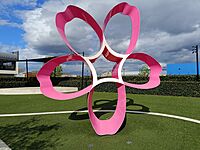 |
0.09 | |
| St Aubyn Street Reserve | St Leonards | 1.30 | ||
| St Leonards Park | St Leonards |  |
4.87 | |
| Queens Square | Parkvale | 1.01 | ||
| Tamatea Street Reserve | Mahora | 0.79 | ||
| William Nelson Park | Hastings Central | 0.60 | ||
| Windsor Park | Mayfair/Parkvale | 26.80 | 1885 |
Notable people
Notable residents of the Hastings metro area have included:
- Rita Angus - artist
- Donna Awatere Huata – former politician
- Geordie Beamish – 2024 World Indoor Athletics Championships, 1500 metres champion
- Joh Bjelke-Petersen – Premier of Queensland, Australia
- Martin Campbell – TV and film director
- Alan Duff – author (Once Were Warriors) and co-founder of Duffy Books in Homes
- Georgina Evers-Swindell – Olympic rowing gold medalist
- Caroline Evers-Swindell – Olympic rowing gold medalist
- Robert Felkin – medical missionary, explorer and ceremonial magician
- Paul Holmes – radio and television broadcaster
- Phil Judd – musician, composer and founding member of Split Enz
- Cobber Kain – first Allied fighter ace of WW2, 14 kills in the Battle of France
- Josh Kronfeld – All Black rugby player who attended Hastings Boys High
- Liam Lawson - Formula One racing driver
- Ross McEwan - Former CEO of Royal Bank of Scotland, now CEO of the National Australia Bank
- John McIntyre - racing driver
- Alfred Meebold – botanist, writer, and anthroposopher
- Greg Murphy – V8 Supercar racer
- George Nēpia – All Black who attended Maori Agricultural College
- Mark Paston – New Zealand representative football goalkeeper
- Abe Phillips - lead singer of Hastings band, The Shadracks
- Bruce Robertson – All Black rugby player who attended Hastings Boys High
- Taine Randell – rugby player who captained the All Blacks and attended Lindisfarne College in Hastings
- Jason Reeves – radio and television host who attended Karamu High School in Hastings
- Ian Smith – New Zealand representative cricketer
- John Timu – rugby player who represented New Zealand in rugby union and rugby league, and attended Lindisfarne College in Hastings
- Kirsten Warner – novelist, poet and journalist
- James Wattie – industrialist/entrepreneur and founder of Wattie's
- Joan Wiffen – amateur palaeontologist who discovered the first dinosaur fossils in New Zealand
- Chrissy Witoko – owner of the Evergreen Coffee Lounge, meeting place for Wellington's LGBTQIA+ community
- Eric Young – Prime TV news presenter
See also
 In Spanish: Hastings (Nueva Zelanda) para niños
In Spanish: Hastings (Nueva Zelanda) para niños






